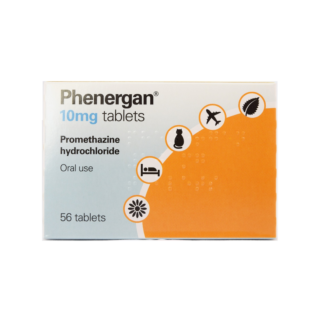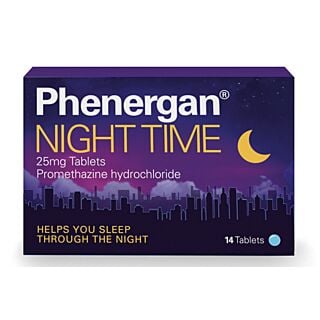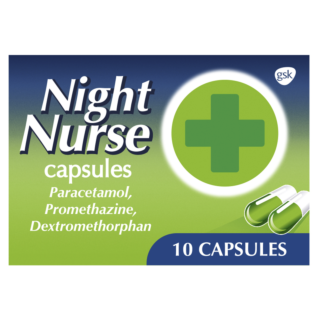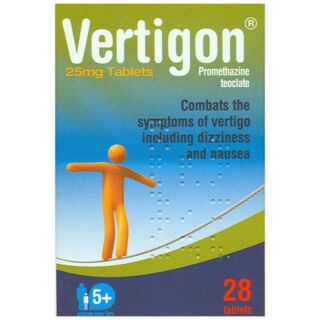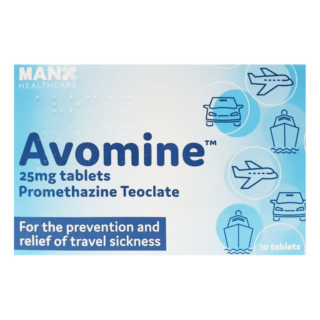7 ways you can use promethazine (Phenergan)

Did you know that promethazine can be used for different things?
Promethazine hydrochloride isn’t a one-trick pony – it has multiple uses, so it’s always a good idea to keep it stocked in your medical cupboard for whenever you might need it. Not only can promethazine treat allergies, but it can also tackle short-term insomnia, motion sickness, cold symptoms and nettle rash.
In this guide we’ll list the 7 ways you can use promethazine – sometimes known by its brand names Phenergan, Sominex and Avomine – and the different types available, like tablets, capsules and liquid formulas. Some versions of promethazine are even suitable for children, too!
What is promethazine?
Promethazine is a type of drowsy antihistamine, meaning it’s more likely to make you feel sleepy than other non-drowsy antihistamines such as fexofenadine and cetirizine.
Most adults are able to take promethazine, but always check with your doctor or pharmacist first if you’re unsure. Children younger than 6 should not be given cough or cold medicines containing promethazine unless it has been prescribed by a doctor.
Additionally, some promethazine medicines are only suitable for children over 12 and 16 years of age. Don’t worry! A medical professional will advise you on which medicines are safest for your child.
The dosage and strength of promethazine differs depending on what it is you’re treating, for example, for short-term insomnia it ranges from 20mg to 50mg taken at night, whereas for hay fever, you’ll typically take 10mg to 20mg two or three times per day.
Always talk to your doctor for advice on how much you can take, as they may recommend a lower or higher dosage depending on the severity of your symptoms.
Like all medicines, promethazine may cause side effects in some people, but not everyone will get them. The side effects of promethazine include feeling tired during the daytime, nightmares, feeling dizzy or unsteady on your feet, difficulty concentrating and headaches.
If you’re over the age of 65, you’re more likely to develop symptoms like feeling confused, a dry mouth, blurred vision and difficulty urinating. Sometimes, promethazine can make your skin more sensitive to the sun – always wear sunscreen with both SPF and UV protection when outdoors, even if it’s rainy and cloudy!
Remember, if you think you’re experiencing a severe allergic reaction to promethazine, symptoms of which include swelling of the face and throat, skin rash, trouble breathing and a loss of consciousness, you must seek emergency medical attention.
Promethazine uses
So, what are the uses of promethazine hydrochloride? From stopping cold-causing runny noses to treating nausea and vomiting, promethazine does it all. Keep reading to find out in more detail what it can do for you and your family.
Hay fever
Hay fever is perhaps one of the most well known conditions promethazine treats, given that it’s a drowsy antihistamine. The usual dosage for hay fever is 10mg twice a day to 20mg, three times a day.
When you come into contact with something you’re allergic to, such as pollen, your body will produce a chemical known as histamine, causing symptoms like sneezing, watery eyes and a blocked nose. Promethazine works by blocking this histamine, ultimately reducing your hay fever symptoms.
Insomnia
As promethazine makes you drowsy, it’s well suited to treating short-term insomnia. Similarly to how it prevents hay fever symptoms, it blocks the chemical histamine, which promotes feelings of wakefulness. It’s a great sleep aid to use, as unlike prescription sleeping tablets such as zopiclone, it’s not addictive.
Motion sickness
Not only does promethazine block the chemical histamine, it also affects other natural substances, too. It blocks the acetylcholine receptors, in addition to acting on certain parts of the brain to prevent nausea and vomiting caused by motion sickness.
If you know you’re going to be affected by motion sickness, you should take 25mg of promethazine 1 to 2 hours before a short journey or 25mg the night before a long journey to prevent any symptoms.
To treat motion sickness, take 25mg as soon as possible and another 25mg the same evening, followed by 25mg the following evening, but only if you need it.

Allergies
Hay fever isn’t the only allergy promethazine is useful for. Whether you’re allergic to pet dander or dust, it can relieve symptoms ranging from itchy, watery eyes to skin reactions such as hives.
The dosage for allergies is the same as hay fever. You'll typically take from 10mg twice a day to 20mg 3 times a day. As this is a drowsy antihistamine, we’d recommend you only take it at night time if your allergies are disturbing your sleep. If you need allergy relief during the day, we’d recommend an alternative, non-drowsy antihistamine like fexofenadine.
Cold symptoms
Promethazine can ease a cough and a runny nose. However, it may also cause side effects like a dry mouth and nose in some people. It works to treat the symptoms of a cold by blocking the effects of the natural chemical acetylcholine.
Remember, you shouldn’t give young children under the age of 6 promethazine for a cold unless it’s been prescribed by a doctor.
Vertigo
Vertigo is a type of dizziness created by the illusion of movement. It presents symptoms similar to motion sickness, like nausea and vomiting.
Surprisingly, vertigo itself isn’t a condition; rather, it’s the symptom of something else, like an inner-ear problem. Promethazine can ease these symptoms of sickness, making vertigo easier to deal with.
Nettle rash
You can get nettle rash when your skin comes into contact with stinging nettles. It appears like hives (a raised rash) that can sting and itch. Taking promethazine works in the same way it treats other allergic reactions, like hay fever, pet dander and insect bites, helping to alleviate your symptoms and bring the rash down.

Whether it’s hay fever season or cold season, there’s always a reason to stock promethazine in your medicine cupboard. Shop with us today to find a remedy for all of the family. From easy-to-take tablets and capsules to liquid formulas ideal for children.
Looking to save the pennies? Instead of choosing the branded version of promethazine, choose a generic version. You’ll still get the same effective product, but it will cost you a lot less!

